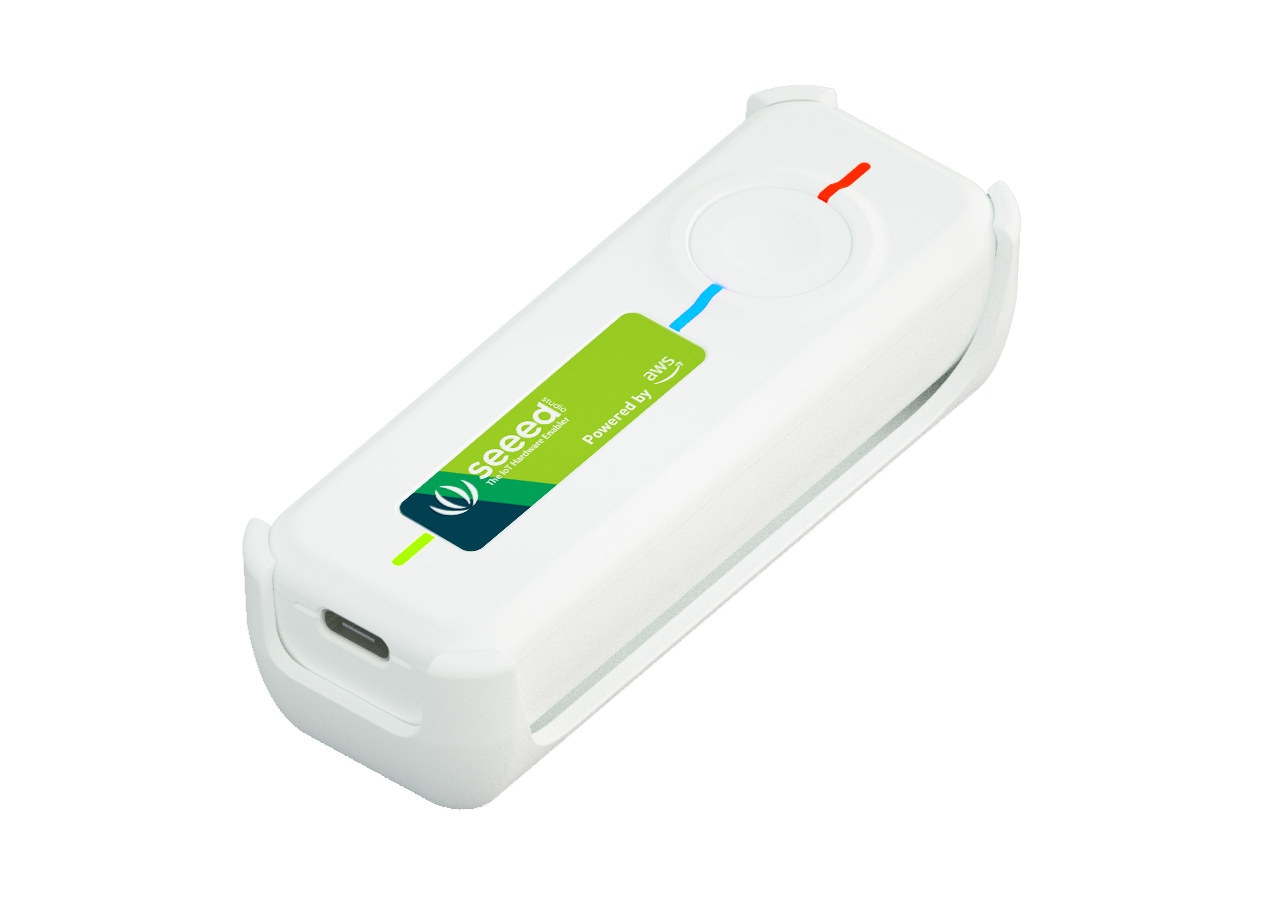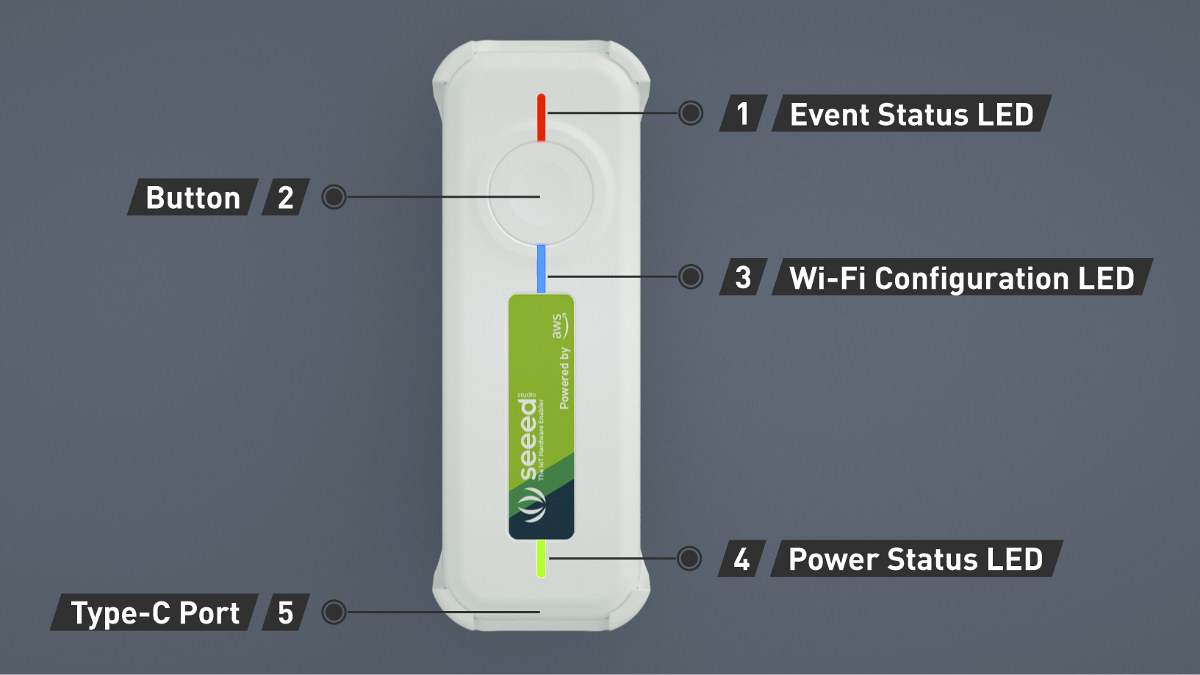Amazon introduced $5 dash buttons in 2015 to let consumers purchase regular items such as washing powder by simply pressing a button. Some people hacked them for other purposes, for instance as WiFi logging buttons, but the company eventually stopped selling the buttons in February 2019 and fully killed those at the end of August.
Seeed Studio is bringing back Amazon Dash button to life in some ways, with the Seeed IoT Button For AWS Wi-Fi-based, programmable button that deploys the AWS IoT 1-Click service.

Seeed IoT Button for AWS hardware specifications:
- MCU – Dual-core MCU with 20MHz Cortex M0 and 200MHz Cortex M4F (Very likely Realtek RTL8720DN Wireless MCU)
- Storage – 4MB flash
- Connectivity – Dual-band Wi-Fi 4 802.11 a/b/g/n (2.4GHz & 5GHz) and Bluetooth 5.0 LE
- USB – 1x USB Type-C port for charging
- Misc – Button good for 100,000 cycles, 3x LEDs (red, green, blue)
- Power Supply
- 5V via USB-C port
- Battery – 3.6V Li-ion 18650 Rechargeable battery (Not included, needs to be purchased locally)
- 500mA charging current
- 4 to 6 hours charging time depending on battery capacity
- Protection – Overcharge, Overcurrent, Over-discharge, and Reverse polarity protection
- Dimensions – 92 x 32 x 25mm
The button supports firmware update over the air (FOTA) and is fully compatible with the official AWS IoT 1-Click app for iOS and Android. Three types of clicks are supported: single, double, and long presses. The button also comes with a stickable bracket that allows you to wall-mount the button, and take it out like you would for a remote control.
Here’s how Amazon describes its AWS IoT 1-Click service:
… enables simple devices to trigger AWS Lambda functions that can execute an action. AWS IoT 1-Click supported devices enable you to easily perform actions such as notifying technical support, tracking assets, and replenishing goods or services. AWS IoT 1-Click supported devices are ready for use right out of the box and eliminate the need for writing your own firmware or configuring them for secure connectivity. AWS IoT 1-Click supported devices can be easily managed. You can easily create device groups and associate them with a Lambda function that executes your desired action when triggered. You can also track device health and activity with the pre-built reports.
Some practical applications include home control, one-click to order takeout button, events logging, Netflix pause button, and more. The Wiki explains how to get started with the button using the mobile app.
Seeed IoT Button for AWS is sold on Seeed Studio for $19.90 including a user manual and stickable bracket, but remember you’d have to purchase the battery separately.

Jean-Luc started CNX Software in 2010 as a part-time endeavor, before quitting his job as a software engineering manager, and starting to write daily news, and reviews full time later in 2011.
Support CNX Software! Donate via cryptocurrencies, become a Patron on Patreon, or purchase goods on Amazon or Aliexpress. We also use affiliate links in articles to earn commissions if you make a purchase after clicking on those links.






mmm IMHO $20 is a bit steep.
Yes — for something that has only one use/purpose — which probably plays into Amazon discontinuing them.
$5 Did not catch on but as dgp points out $20 plus a battery ouch!
Alexa, Phone app etc
The Amazon buttons were subsidized down to $5. They probably cost around $7 to make since they had some fairly expensive silicon (for the time) in them.
The Amazon Button was a popular product and in widespread use, it did not fail as a consumer item. Instead it was lawyers that destroyed it. In both the US and Germany class action lawyers attacked Amazon because the button did not show the current price of the item before you pushed it. The claim was “deceptive trade practice” since the price on subsequent pushes was usually slightly higher.
As a consumer I had no problem with this, sure the price was a little higher but it was typically only a penny or two. It was just the natural course of price inflation. After pushing Amazon also sent you an email with the price that included a link to cancel the order if you did not like the price.
But the lawyers are greedy and managed to take Amazon down for millions of dollars over this thus causing Amazon to deactivate all of the buttons in the world.,
I already have a piece of hardware called a “smart phone” that communicates just fine with Amazon.
Why not just give each customer a list of quick re-order links on Amazon.com that shows the current price? No dedicated, special purpose, subsidized hardware required.
If it can be done with a hardware button, the same (or better) could be done with a software button at lower cost and without the legal issues.
We had a couple buttons by the washing machine for supplies. It was very convenient. Finish off the detergent, just poke the button.
That is convenient? I’m also a tech lover… But is it really an advantage getting washing powder from amazon instead of a local retailer?
Just asking as here amazon is not available, except for books being sent from an eighbouring country. There are of course plenty of online shops selling whatever you might require or desire, but I never had an itch to order such things from any of them…
The wife does not want to carry heavy bottles of the liquid detergent she likes to use. Much easier to have them appear on the doorstep and then I can carry them upstairs. She also orders a lot of groceries online for the same reason.
“… just poke the button”.
I think there might be just a little more to the legal aspect of this story.
Amazon uses your purchase history to set pricing. It’s called “price optimization”. You and I won’t necessarily get the same price on the same item.
Basically, they have a “sucker score” for how price sensitive you are. If they decide you’re a “sucker”, you get a higher price than I do. I’ve seen it done.
I’ll bet that every time you poked that “dash button”, your “sucker score” increased and the price of your detergent went up — just a few pennies each time.
Big data is not used to benefit the suckers. Lost of companies are getting in on the act — insurance for example.
https://www.cnbc.com/2014/04/16/data-mining-is-now-used-to-set-insurance-rates-critics-cry-fowl.html
https://www.reuters.com/article/us-amazon-com-germany-court/court-says-amazon-dash-buttons-violate-german-law-idUSKCN1P42HW